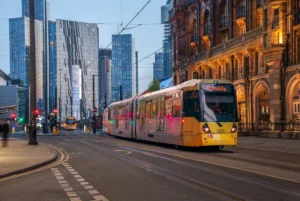The Rise of Flexible Office Space: A London Market Report
By Roy Fiszer-Watson, Compare The Offices | Published on 29 August 2025
For those of us who have been observing the London property market for years, what we are witnessing is nothing short of a paradigm shift. It’s a quiet revolution that has moved from the fringes to the very centre of the commercial real estate world. I’m talking about the rise of flexible office space. What was once a niche product for freelancers and startups has exploded into a dominant force, fundamentally reshaping the city’s landscape. This isn’t just a feeling or an observation; it’s a story told emphatically by data. In this market report, we will dive deep into the numbers, analysing the trends, occupancy rates, and future projections that define this new era.
At Compare The Offices, our impartial service gives us a unique, bird’s-eye view of the market. We see the data in real-time as thousands of businesses search for their new home. This report is a culmination of that insight, designed to give you a clear, data-driven understanding of where the market is and, more importantly, where it is going. The future of work in London is flexible, and the numbers prove it.
Market Share Growth: From Niche to Mainstream
A Decade of Explosive Growth
A decade ago, flexible workspace accounted for less than 2% of London’s total office stock. Today, that figure has surged to over 8% in Central London, and in some creative and tech-focused submarkets like Shoreditch and Farringdon, it’s well into double digits. This isn’t just steady growth; it’s an exponential curve, as the chart below clearly demonstrates. The initial rise was fuelled by the post-2008 financial crisis boom in startups and the tech sector, which demanded shorter, more agile lease structures than the traditional market could offer. However, the global pandemic acted as a massive accelerant. Businesses were forced to reconsider the very purpose of the office, and the rigidity of the 10-year lease was exposed as a major liability. The flexible model, with its short-term contracts, all-inclusive pricing, and inherent scalability, became the obvious, de-risked solution for businesses navigating unprecedented uncertainty.
Flexible Office Space as % of Total London Office Stock
Occupancy & Demand: A Story of V-Shaped Resilience
Why Flexibility is Winning the Occupancy Battle
The post-pandemic office market has been a tale of two sectors. While the overall London office market saw occupancy rates plummet and then stagnate, the flexible sector has experienced a remarkable “V-shaped” recovery. Why? Because it directly answers the needs of the hybrid work model. As companies formalised hybrid policies, they realised they no longer needed a desk for every employee, five days a week. This made their vast, traditionally leased offices feel like ghost towns. They began to shed this excess space and instead invest in higher-quality, centralised hubs for collaboration, culture, and connection. Flexible providers are perfectly positioned to meet this demand, offering a ‘space-as-a-service’ model that aligns cost directly with actual usage and headcount. This has made the sector far more resilient and dynamic than the traditional market, which is still burdened with vast amounts of under-utilised, second-hand space. The rise of flexible office space is a direct result of this superior adaptability.
Occupancy Rates: Flexible vs. Traditional Office Space
Access the Entire Flexible Market in One Place
The flexible market is vast and varied. Our platform gives you access to hundreds of providers across London, allowing you to compare options and find the perfect fit, all for free.
Start Your Market Search TodayWho is Driving the Demand? A Deep Dive into the Sectors
A Look at the Key Industry Sectors
While the tech and creative industries were early adopters, the demand for flexible space is now incredibly diverse. The chart below highlights the key sectors taking up flexible space today, and the reasons are nuanced. The dominant Tech & Media sector (40%) values flexibility for its rapid scaling needs and the vibrant, collaborative communities that providers foster. Professional Services (25%), including consultants and accountants, use flexible space for project teams and as prestigious, client-facing meeting hubs without the long-term overhead. The Finance & Insurance sector (15%) is increasingly using flexible offices for FinTech innovation labs and specialist teams, separating them from the culture of the main corporate headquarters. Even large Corporate occupiers (10%) are now major players, using the flexible market strategically to establish ‘hub-and-spoke’ models with smaller satellite offices closer to where their employees live. This diversification of demand is a clear sign of market maturity and a core driver of the rise of flexible office space.
Flexible Space Demand by Industry Sector (2025)



Future Projections: What’s Next for the Flexible Market?
The Growth is Set to Continue and Diversify
All market indicators suggest that the rise of flexible office space is far from over. We project that flexible workspaces will account for as much as 15-20% of London’s total office stock by 2030. The key trends driving this will be a diversification of the product itself.
- The Flight to Quality: As businesses adopt hybrid models, they are demanding higher quality spaces to make the commute worthwhile. The focus is shifting to premium, amenity-rich environments that foster collaboration and wellbeing. We expect to see continued strong growth in the high-end serviced office market.
- The Rise of Management Agreements: Traditional landlords are increasingly partnering with flexible office providers to manage floors in their buildings. This allows landlords to offer a flexible product without developing the operational expertise themselves, and it gives tenants access to bespoke, branded space on flexible terms. This ‘Managed Office’ solution is the fastest-growing segment of the market.
- Suburban Hubs & The ‘Hub-and-Spoke’: The ‘hub-and-spoke’ model will drive demand for high-quality flexible spaces in London’s outer zones and commuter towns like Richmond, Wimbledon, and Croydon. This allows businesses to offer their employees the option to work closer to home, reducing commute times and improving work-life balance.
Projected Growth by Flexible Office Model (2025-2028)
Stay Ahead of the Market Trends
The office market is changing fast. Talk to our experts to understand the latest trends and ensure your workspace strategy is fit for the future.
Get a Free Market ConsultationConclusion: A Market Remade
The data tells an undeniable story. The London office market has been fundamentally and permanently reshaped. Flexibility is no longer a perk; it’s a core requirement for any business that wants to attract top talent, manage its finances prudently, and adapt to an uncertain world. The rise of flexible office space is a direct response to these needs. It represents a more intelligent, efficient, and human-centric way of thinking about the workspace. As we look to the future, it’s clear that the providers and businesses that embrace this new reality are the ones who will thrive.







